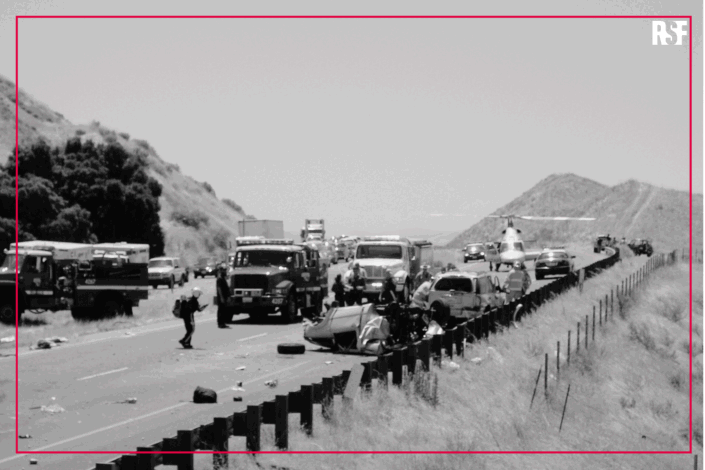“Hostile Environment Awareness Training (HEAT) for journalists” is a ten-part series developed by Reporters Without Borders (RSF), Silk Road Training and a local partner. This eighth article outlines how to stay safe during vehicle travel and respond effectively to road traffic collisions (RTCs).
Hostile Environment Awareness Training (HEAT) is a comprehensive safety training course covering core areas of preparedness for journalists working in high-risk environments. It includes preparedness for civil unrest, conflict zones, hostile environment first aid, vehicle safety, and digital security. Journalists reporting in hostile environments can face risks from driving fatigue, vehicle failure, and poor road maintenance in addition to criminal or conflict-related threats.
1 – Prepare your vehicle before travel
Safe travel starts before the engine turns on. Choosing the right vehicle, preparing essential gear, and checking the vehicle’s condition can prevent breakdowns or complications in remote or hostile environments.
- Choose the right vehicle. Use one suited to the terrain, capable of carrying people and gear without overloading.
- Use the P.O.W.D.E.R.Y checklist to test your vehicle’s condition:
Petrol: Ensure there is enough fuel.
Oil: Check engine oil levels.
Water: Radiator and windscreen fluids.
Damage: Look for dents or mechanical issues.
Electrics: Test lights, horn, indicators.
Rubber: Inspect tyre pressure and tread.
You: Assess your own fitness to travel.
- Keep maintenance essentials handy. Carry a spare wheel or two, a 3-tonne bottle jack, wheel brace and locking nuts, a tyre pressure gauge, and the standard manufacturer’s toolkit.
- Stow gear safely. Loose items become projectiles in crashes. Use secure cages, nets, or straps to keep gear in place.
- Carry a safety bag. Include a trauma kit, communications tools, map, water, food, a torch, and blankets.
- Check documentation. Ensure licences, insurance, and vehicle papers are in order.
2 – Stay alert while on the road
Even experienced drivers can become vulnerable in unfamiliar or high-stress settings. Fatigue, distraction, and poor judgement increase the chance of accidents.
- Drive cautiously. Observe local laws and adjust for weather, road conditions, or conflict zones.
- Leave escape space. Keep distance in traffic. Always plan an exit if ambushed or blocked.
- Watch for fatigue. Take breaks, rotate drivers, and avoid travel after dark.
- Wear seatbelts at all times. All passengers should be strapped in, front and back.
3 – Respond to road traffic collisions (RTCs)
If you come across or are involved in a collision, remain calm. Securing the scene, assessing danger, and providing structured help is more valuable than rushing in.
- Assess if it is safe to stop. Be aware of oncoming traffic or conflict nearby.
- Block traffic if needed. Use your vehicle or another nearby one to shield the scene.
- Assess the crash site for danger. Before approaching, check for fuel spills, fire risk, or other hazards.
- Approach from the front. Avoid startling those involved in the crash. Speak clearly and stay calm.
Provide basic care:
- Turn off engines in damaged vehicles. Apply handbrakes and watch for undeployed airbags.
- Control bleeding. Prioritise life-threatening bleeds using direct pressure or a tourniquet.
- Support the airway and neck. Use DR-CAB and stabilise the head and neck if spinal injury is suspected.
- Conduct a secondary assessment. Once stable, assess for other injuries.
- Only move injured persons if necessary. If they are not breathing, are in immediate danger, or if no help is coming.
4 – Prevent future incidents
- Communicate with drivers. Discuss routes, responsibilities, and emergency plans before going on the road again.
- Pack correctly. Always keep equipment well-organised and weighted low in the vehicle.
- Rest and rotate. Fatigue is a major cause of crashes; build breaks into your schedule when driving again.
This article is based on the content of a three-day HEAT training conducted by Silk Road Training and organised by Reporters Without Borders (RSF) and a local partner.
Silk Road Training offers online and in-person HEAT training led by expert trainers with over 20 years of training and security advisory experience globally to help media professionals and frontline journalists build life-saving skills in high-risk areas.
← Read Part 1: Preparing for civil unrest
← Read Part 2: Techniques to stay safe during civil unrest
← Read Part 3: Planning ahead in conflict zones
← Read Part 4: Responding to conflict threats in the field
← Read Part 5: First Aid – Assessing casualties, managing catastrophic bleedings
← Read Part 6: First Aid – Airway management and resuscitation
← Read Part 7: First Aid – Monitoring casualties and secondary assessments
→ Read Part 9: Let’s not forget digital security
→ Read Part 10: A step-by-step digital security protocol



